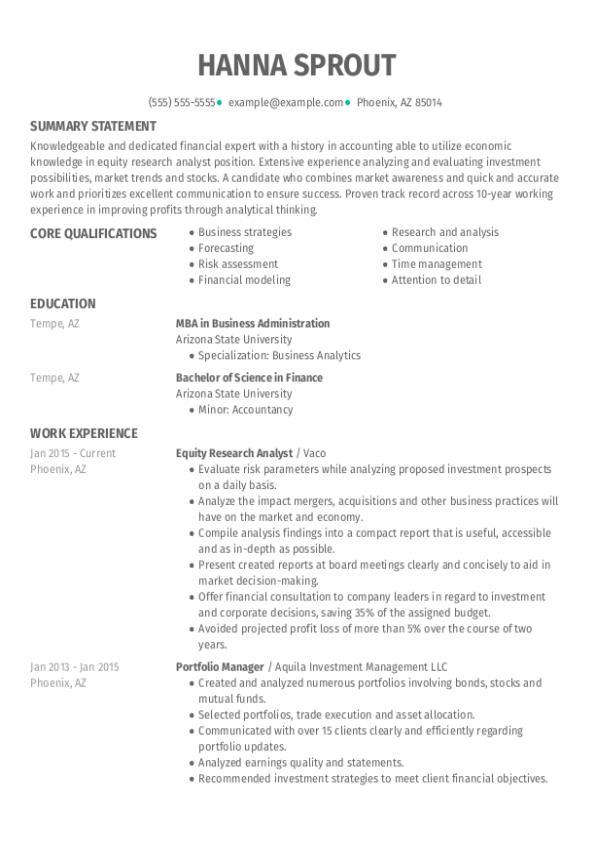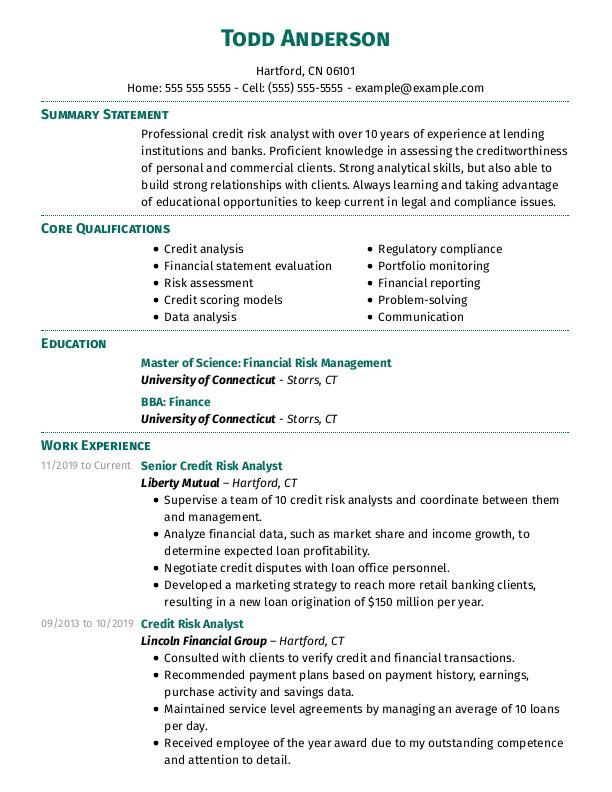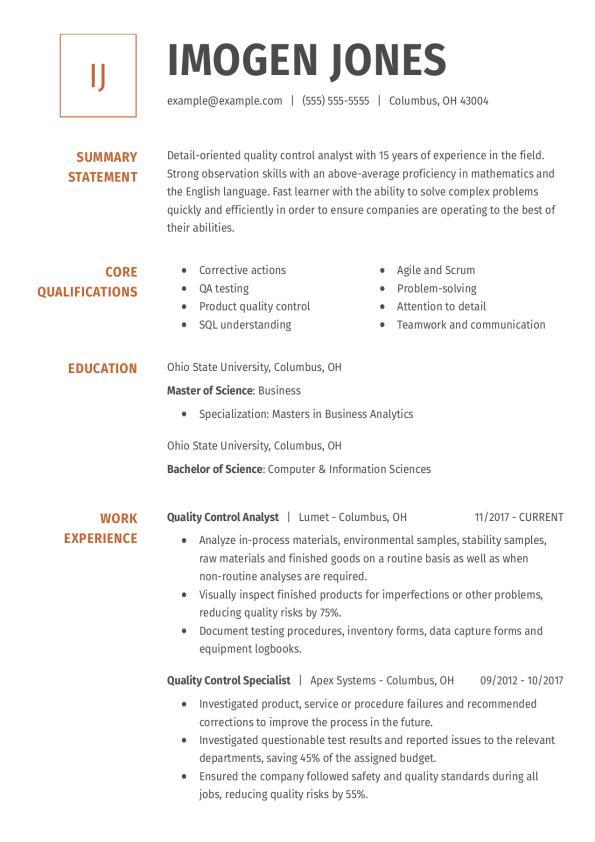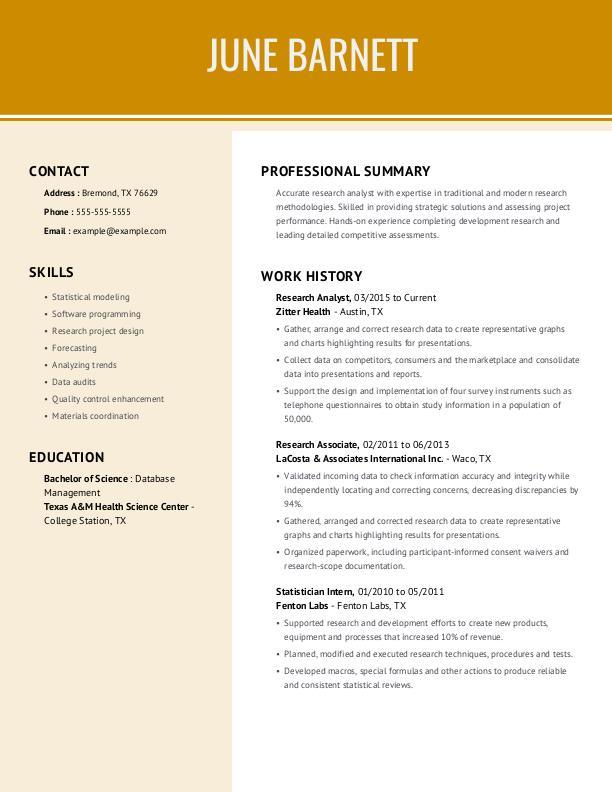Why this resume works
- Quantifies accomplishments: Measurable accomplishments like analyzing benefits plans for over 200 employees monthly and saving $75K through optimized processes showcase the applicant’s impact and value.
- Showcases career progression: The applicant’s journey from an HR analyst to a benefits analyst shows a clear trajectory of tackling greater responsibilities and career progression.
- Illustrates problem-solving ability: Implementing a data-driven compensation approach that increased efficiency illustrates the applicant’s problem-solving skills and knack for identifying solutions.
More Benefits Analyst Resume Examples
Browse our benefits analyst resume examples to effectively highlight your analytical skills and experience. These human resources resume samples will help you craft a resume that appeals to employers seeking expertise in employee benefits management.
Entry-Level Benefits Analyst
Why this resume works
- Centers on academic background: The applicant’s education section emphasizes degrees in business administration and human resources, showcasing a commitment to learning foundational skills early in their career journey.
- Effective use of keywords: Strategically integrating role-specific terms like benefit plan analysis and data-driven decision-making reflects a thoughtful approach to incorporating keywords that boost ATS compatibility.
- Shows digital literacy: By highlighting expertise in tools for cost-benefit and market trend analysis, the applicant effectively conveys computer skills and digital readiness.
Mid-Level Benefits Analyst
Why this resume works
- Points to measurable outcomes: The applicant’s ability to reduce benefit costs by 15% and streamline processes highlights a results-driven mindset with tangible outcomes that resonate across their professional roles.
- Demonstrates language abilities: Language skills in Spanish, French, and German support cross-cultural communication, improving collaboration in diverse settings.
- Displays technical expertise: Certifications like Certified Employee Benefits Specialist and expertise in compliance management reflect a strong foundation of technical knowledge important for navigating complex benefits systems.
Experienced Benefits Analyst
Why this resume works
- Showcases impressive accomplishments: By detailing the implementation of cost-effective programs and significant savings, the applicant’s accomplishments paint a picture of senior-level impact.
- Lists relevant certifications: The inclusion of Certified Employee Benefits Specialist and Professional in Human Resources certifications shows a strong commitment to professional growth and expertise.
- Emphasizes leadership skills: Managing benefits for thousands while driving policy negotiations highlights the applicant’s ability to leverage leadership skills effectively across departments.
Benefits Analyst Resume Template (Text Version)
Suki Jones
Minneapolis, MN 55404
(555)555-5555
Suki.Jones@example.com
Professional Summary
Experienced Benefits Analyst with expertise in optimizing benefits programs and improving employee satisfaction. Proven track record of data-driven decisions and successful process improvements.
Work History
Benefits Analyst
Pinnacle Benefits Solutions – Minneapolis, MN
July 2023 – July 2025
- Analyzed benefits plans for 200+ employees monthly
- Saved K by optimizing enrollment processes
- Increased employee satisfaction by 20%
Compensation Specialist
Value Added Partners – Minneapolis, MN
July 2020 – June 2023
- Streamlined compensation models, saving K
- Developed a new salary structure, boosting practices
- Improved report accuracy by 15%
HR Analyst
Insight HR Consulting – Cedar Valley, MN
July 2019 – June 2020
- Enhanced data analytics processes by 30%
- Reduced processing time by 25%
- Audited HR data, ensuring compliance
Skills
- Benefits Administration
- Data Analysis
- Compensation Strategies
- HRIS Systems
- Employee Relations
- Regulatory Compliance
- Project Management
- Process Improvement
Certifications
- Certified Benefits Professional – American Benefits Association
- HR Analysis and Analytics – HR Certification Institute
Education
Master’s Human Resources Management
Northwestern University Evanston, Illinois
June 2018
Bachelor’s Business Administration
University of Wisconsin-Madison Madison, Wisconsin
June 2016
Languages
- Spanish – Beginner (A1)
- French – Intermediate (B1)
- German – Beginner (A1)
Related Resume Guides
Advice for Writing Your Benefits Analyst Resume
Explore our advice on how to write a resume for a benefits analyst role and discover how to highlight your knack for data analysis and expertise in employee benefits.

Highlight your most relevant skills
Listing relevant skills on your resume is important because it shows employers why you are a good fit for the job. For a benefits analyst, it’s key to list both technical and interpersonal skills.
Technical skills might include data analysis, knowledge of employee benefits software, or understanding of regulations. Interpersonal skills could be communication, problem-solving, and teamwork. By showing you have a mix of both kinds of skills, you make it clear that you can handle the different parts of the job.
Creating a dedicated skills section helps organize this information so employers can see your strengths easily. Make sure to balance hard and soft skills in this section. Additionally, when describing your past jobs in the work experience section, try to mention how you’ve used these key skills before.
This makes your application stronger because it provides concrete examples of how you’ve applied your skills in real situations. Integrating these details not only highlights what you’re good at but also shows employers how you’ve successfully used these abilities in similar roles before.
For benefits analysts, choose a resume format that highlights analytical skills, attention to detail, and skill with data management tools right away.
Showcase your accomplishments
When organizing your work experience as a benefits analyst, always list your jobs in reverse chronological order. This means you start with your most recent position and work backward.
For each job entry, include the job title, employer name, location, and the dates you worked there. This helps employers see your career progression at a glance.
Instead of just listing what you did in each role, focus on quantifying your accomplishments. For example, instead of saying “managed employee benefits,” say “improved employee benefits enrollment by 20%.” Turn duties into achievements by showing measurable results like percentages or time savings.
Use action words like “increased,” “reduced,” or “streamlined” to describe what you’ve done. These words make your resume more dynamic and help potential employers quickly understand the impact you’ve had in previous roles. Quantified accomplishments give hiring managers a clear picture of your skills and contributions as a benefits analyst.
5 benefits analyst work history bullet points
- Analyzed benefits data for over 1,000 employees, identifying cost-saving opportunities that reduced expenses by 15%.
- Streamlined health and wellness program enrollment processes, decreasing processing time by 40% and improving employee satisfaction.
- Collaborated with cross-functional teams to implement a new benefits platform, improving user experience and reducing inquiries by 25%.
- Conducted comprehensive market research on competitive benefits packages, leading to the successful negotiation of more favorable terms with vendors.
- Developed monthly reports on benefits utilization trends, providing actionable insights that informed strategic planning and policy adjustments.
Choose a resume template with bold headings and readable fonts, keeping the design simple to ensure your skills and work history remain the focus.
Write a strong professional summary
A professional summary on a resume serves as an introduction for hiring managers, providing a snapshot of your skills and accomplishments. You can decide whether to use a summary or a resume objective based on your experience level and career goals.
A professional summary is typically three to four sentences long, highlighting your experience, key skills, and notable achievements. It’s best for those with work history who want to emphasize what they’ve accomplished in their field.
In contrast, resume objectives focus on career goals and are suited for entry-level individuals or those changing careers or with employment gaps. While summaries say “what I’ve accomplished,” objectives state “what I aim to contribute.”
Next, we’ll provide examples of both types of introductions for various industries and levels of experience, offering you clear guidance on tailoring your resume effectively. Explore our library of resume examples for additional inspiration.
Benefits analyst resume summary examples
Entry-level
Recent Bachelor of Science graduate in human resources management with a focus on benefits administration. Completed an internship at a well-known insurance firm, gaining foundational skills in analyzing employee benefits packages and assisting in open enrollment processes. Certified Associate in Project Management (CAPM) and eager to apply analytical skills to support effective benefits solutions.
Mid-career
Results-driven benefits analyst with over six years of experience in managing comprehensive employee benefits plans for mid-sized companies. Expertise in conducting cost analysis, negotiating with vendors, and improving benefit communication strategies. Known for strong analytical abilities and a collaborative approach, ensuring alignment of benefits programs with organizational goals.
Experienced
Seasoned benefits analyst with more than 15 years of experience leading complex projects involving multi-state employee benefit schemes. Recognized for strategic leadership in optimizing benefits offerings through data-driven insights and stakeholder engagement. Successfully led initiatives that reduced costs by 20% while maintaining high employee satisfaction scores. Committed to fostering a culture of health and wellness within organizations.
Benefits analyst resume objective examples
Recent graduate
Detail-oriented recent graduate with a bachelor’s degree in human resources seeking an entry-level benefits analyst position. Eager to apply analytical skills and HR knowledge to support the development and management of employee benefit programs that improve workforce satisfaction.
Career changer
Former sales professional transitioning into benefits analysis, bringing strong data interpretation and client interaction skills. Looking to contribute to a collaborative team by improving benefit structures that align with organizational goals and employee needs.
Specialized training
Aspiring benefits analyst with specialized training in compensation management eager to join a forward-thinking company. Passionate about using acquired skills to assist in evaluating and implementing effective benefit solutions that promote overall employee well-being.
Our Resume Builder makes it simple to highlight your benefits analysis skills with professional templates and content suggestions.
Match your resume to the job description
Tailoring resumes to job descriptions is important for standing out to employers and navigating applicant tracking systems (ATS). By customizing your resume, you increase the chances of it being noticed by hiring managers, helping you secure an interview.
An ATS-friendly resume includes keywords and phrases that match the skills required for the role. This alignment helps ensure your resume gets through the initial screening process.
When a resume mirrors the language in a job description, it signals to employers that you possess relevant expertise and qualifications. To identify keywords from job postings, look for skills, qualifications, and duties mentioned multiple times. For example, in a benefits analyst position, terms like “data analysis,” “employee benefits,” or “report generation” might be common.
Incorporate these terms naturally into your resume content by rewriting job descriptions. For instance, transform “Analyze employee benefit programs” into “Conducted data analysis on employee benefit programs to optimize offerings.”
This approach ensures the keywords fit seamlessly within your experience. It not only boosts your chances of passing initial screenings but also demonstrates that you’re a strong match for the role, increasing opportunities for interviews and job offers.
You can use our ATS Resume Checker to scan your resume for common issues and receive on-the-spot feedback to improve your resume score.
FAQ
Do I need to include a cover letter with my benefits analyst resume?
Yes, including a cover letter with your benefits analyst resume can set you apart and make your application more compelling.
A cover letter lets you explain why you’re interested in the role and showcase how your analytical skills align with the company’s needs for managing employee benefits programs.
For instance, if the organization uses specific software or has unique benefits processes, you can highlight relevant experience or certifications that match their requirements.
It’s also a great opportunity to show your ability to communicate complex information clearly—a key skill for benefits analysts who often work closely with HR teams and employees.
Consider reviewing cover letter examples or using our Cover Letter Generator to create a polished draft tailored specifically for a benefits analyst position.
How long should a benefits analyst’s resume be?
For a benefits analyst, a one-page resume is usually enough to showcase your main skills, like expertise in benefits administration, data analysis, and compliance with regulations. Highlight measurable achievements such as improving benefits processes or cutting costs.
If you have over 10 years of experience or advanced certifications like CEBS, a two-page resume might be fitting. Ensure everything included is relevant, focusing on recent roles and key accomplishments that show your value.
For more tips and examples, check resources on how long a resume should be based on experience and role.
How do you write a benefits analyst resume with no experience?
When crafting a resume with no experience for a benefits analyst role, emphasize your relevant skills, education, and any related experiences that showcase your potential for the position. Here are a few tips to help you get started:
- Emphasize your education: Start by listing your degree in a relevant field like human resources, business administration, or finance. Include the name of your school, graduation date, and any academic honors or relevant coursework.
- Showcase transferable skills: Highlight skills such as data analysis, attention to detail, communication, and skill with software tools (like Excel) that are useful in a benefits analyst role. These can come from school projects, part-time jobs, or internships.
- Include related experiences: If you’ve had internships or volunteer work involving HR tasks or data management, describe those roles and what you accomplished. Even unrelated jobs can show valuable soft skills like problem-solving and teamwork.
- Add certifications and training: List any certifications or online courses related to benefits administration, HR principles, or data analysis. This shows your commitment to learning and growing in the field.
Tailoring your resume this way will help demonstrate that you have the foundational knowledge and skills needed to succeed as a benefits analyst.
Rate this article
Benefits Analyst
Additional Resources

Equity Research Analyst Resume Guide + Tips + Example
So, you’re in the market for a job as an equity research analyst. A well-crafted Resume is a great place to start! Our guide to creating the perfect equity research

Credit Risk Analyst Resume Examples & Templates
Credit risk analysts help determine the level of risk involved when organizations or individuals lend money or extend credit. Crafting a compelling Resume is crucial for advancing your career as a

Quality Control Analyst Resume Guide + Tips + Example
Propel your career with a well-written quality analyst Resume. With our guide, you can create a professional quality analyst Resume to showcase your skills and present you as a desirable

Data Analyst Cover Letter Examples & Templates
Data analysts are essential positions in most job industries. They collect, process, and analyze data to help companies make informed business decisions. A well-written cover letter for a data analyst

Data Analyst Resume Examples & Templates
Data analysts are experts in processing and presenting data in ways that help organizations and companies. Beyond your excellent database knowledge and data visualization expertise, your data analyst resume must

Research analyst Resume Guide + Tips + Example
Advance your research analyst career with a strong resume. We have the perfect guide to help you, with tips on what to add, skills to include, and how using a
